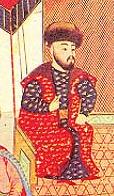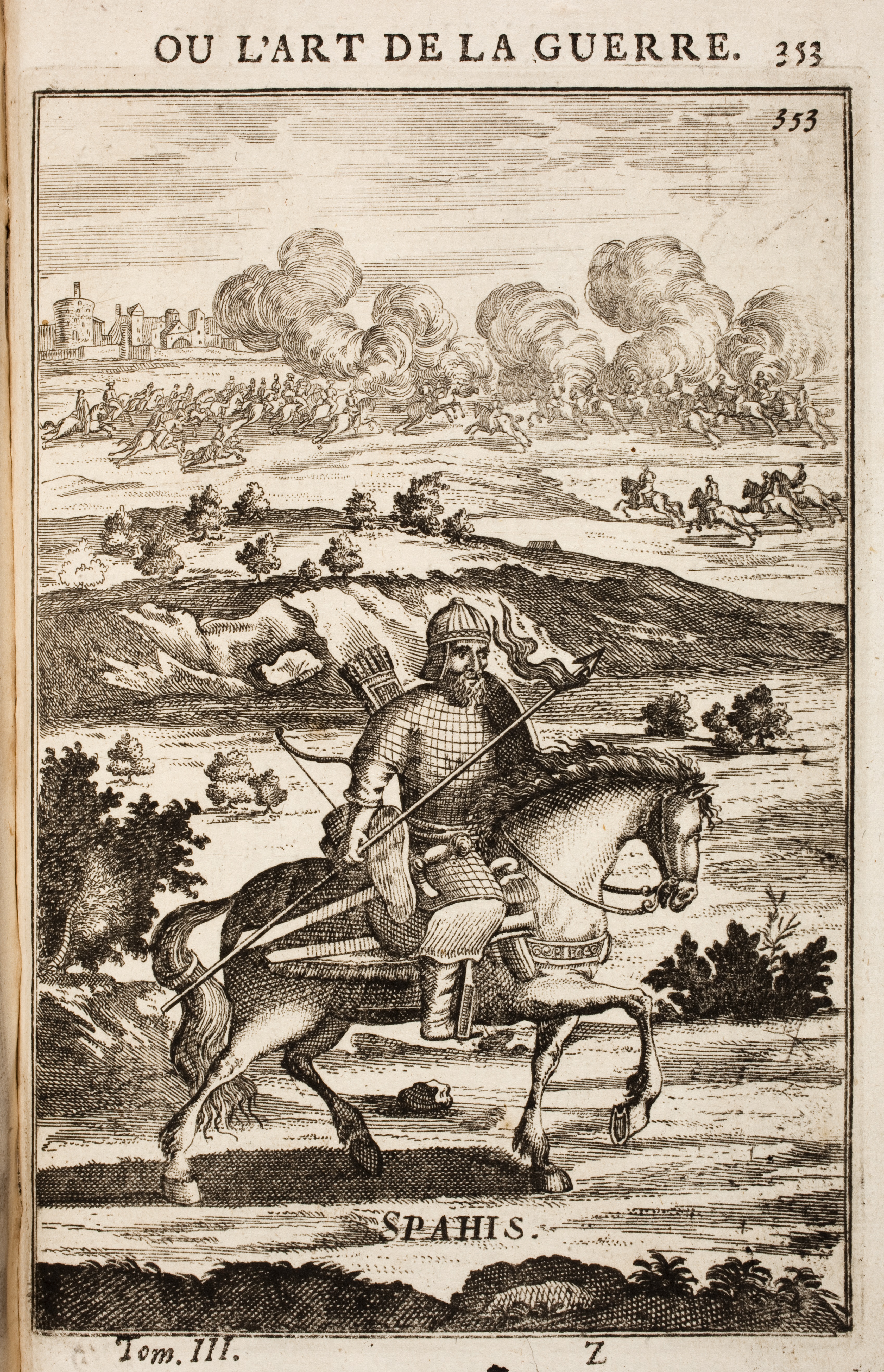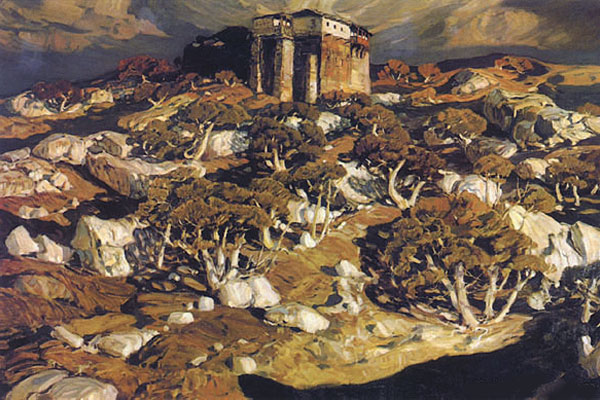|
Saadet I Giray
Saadet I Giray (1492вҖ“1538) was Khan of the Crimean Khanate (reigned 1524вҖ“1532). He was pro- Ottoman and a competent ruler. He followed ДһazДұ I Giray (1523вҖ“24) and was followed by Д°slГўm I Giray (1532). Service in Turkey (1512вҖ“1524) He was one of the eight sons of Crimean Khan Mengli Giray (reigned 1478вҖ“1515). Ottoman Sultan Bayezid II (r. 1481вҖ“1512), late in his reign, faced rebellions of his two sons, Еһehzade Ahmet and Selim "the Grim". Selim's wife was the daughter of Mengli Giray.For doubts about this see Hafsa Sultan (wife of Selim I). In 1511 or 1512 Mengli sent troops under his son Saadet to aid his son-in-law. Selim won and replaced his father. Saadet suppressed revolts in Anatolia, married a daughter of Selim and was a favorite of both Selim I the Grim (r. 1512вҖ“1520) and his son Suleiman the Magnificent (r. 1520вҖ“1566). As Khan 1524вҖ“1532 When Saadet's brother Mehmed I was killed at Astrakhan he was followed by his son ДһazДұ I Giray (r. 1523вҖ“24). ... [...More Info...] [...Related Items...] OR: [Wikipedia] [Google] [Baidu] |
List Of Crimean Khans
This is a list of khans of the Crimean Khanate, a state which existed in present-day southern Ukraine from 1441 until 1783. Crimean Tatars, although not a part of the Ukrainian Ethnic group, ethnos, are deeply interconnected, having ruled a large part of modern History of Ukraine, Ukraine over the span of 300 years. The position of Khan in Crimea was electoral and was picked by beys from four of the most noble families (also known as Qarachi beys: Argyns, Kipchaks, Shirins, and Baryns) at kurultai where the decision about a candidate was adopted.Giray - Khan dynasty of Crimea Khan's Palace website (unavailable currently). The newly elected Khan was raised on a white felt sheet and over him were read Islamic prayers, after that the Khan was triumphantly enthroned. [...More Info...] [...Related Items...] OR: [Wikipedia] [Google] [Baidu] |
Hafsa Sultan (wife Of Selim I)
Hafsa Sultan ( ota, ШӯЩҒШөЩҮ ШіЩ„Ш·Ш§ЩҶ, "''Young lioness''"; or before вҖ“ 19 March 1534), also called AyЕҹe Hafsa Sultan, was a concubine of Selim I and the first Valide Sultan of the Ottoman Empire as the mother of Suleiman the Magnificent. During the period between her son's enthronement in 1520 and her death in 1534, she was one of the most influential persons in the Ottoman Empire. Origins The traditional view holding that Hafsa Sultan was the daughter of MeГұli I Giray (1445вҖ“1515), the khan of the Crimean Tatars for much of the period between 1466 and 1515, resting on seventeenth century western authors accounts, has been challenged in favor of a Christian slave origin based on Ottoman documentary evidence. Only few historians still follow the traditional view, including Brian Glyn Williams. ReЕҹat Kasaba mentions the marriage between Selim I and Hafsa Sultan as the "last marriage between an Ottoman sultan and a member of a neighboring Muslim royal family". Esin AtДұl, ho ... [...More Info...] [...Related Items...] OR: [Wikipedia] [Google] [Baidu] |
Crimean Khans
Crimea, crh, РҡСҠСӢСҖСӢРј, QДұrДұm, grc, ОҡО№ОјОјОөПҒОҜОұ / ОӨОұП…ПҒО№ОәО®, translit=KimmerГӯa / Taurikбё— ( ) is a peninsula in Ukraine, on the northern coast of the Black Sea, that has been occupied by Russia since 2014. It has a population of 2.4 million. The peninsula is almost entirely surrounded by the Black Sea and the smaller Sea of Azov. The Isthmus of Perekop connects the peninsula to Kherson Oblast in mainland Ukraine. To the east, the Crimean Bridge, constructed in 2018, spans the Strait of Kerch, linking the peninsula with Krasnodar Krai in Russia. The Arabat Spit, located to the northeast, is a narrow strip of land that separates the Sivash lagoons from the Sea of Azov. Across the Black Sea to the west lies Romania and to the south is Turkey. Crimea (called the Tauric Peninsula until the early modern period) has historically been at the boundary between the classical world and the steppe. Greeks colonized its southern fringe and were absorbed by the Ro ... [...More Info...] [...Related Items...] OR: [Wikipedia] [Google] [Baidu] |
Safavid Iran
Safavid Iran or Safavid Persia (), also referred to as the Safavid Empire, '. was one of the greatest Iranian empires after the 7th-century Muslim conquest of Persia, which was ruled from 1501 to 1736 by the Safavid dynasty. It is often considered the beginning of modern Iranian history, as well as one of the gunpowder empires. The Safavid ShДҒh IsmДҒ'Д«l I established the Twelver denomination of ShД«Кҝa Islam as the official religion of the empire, marking one of the most important turning points in the history of Islam. An Iranian dynasty rooted in the Sufi Safavid order founded by Kurdish sheikhs, it heavily intermarried with Turkoman, Georgian, Circassian, and Pontic GreekAnthony Bryer. "Greeks and TГјrkmens: The Pontic Exception", ''Dumbarton Oaks Papers, Vol. 29'' (1975), Appendix II "Genealogy of the Muslim Marriages of the Princesses of Trebizond" dignitaries and was Turkish-speaking and Turkified. From their base in Ardabil, the Safavids established control ove ... [...More Info...] [...Related Items...] OR: [Wikipedia] [Google] [Baidu] |
Sultan
Sultan (; ar, ШіЩ„Ш·Ш§ЩҶ ', ) is a position with several historical meanings. Originally, it was an Arabic abstract noun meaning "strength", "authority", "rulership", derived from the verbal noun ', meaning "authority" or "power". Later, it came to be used as the title of certain rulers who claimed almost full sovereignty (i.e., not having dependence on any higher ruler) without claiming the overall caliphate, or to refer to a powerful governor of a province within the caliphate. The adjectival form of the word is "sultanic", and the state and territories ruled by a sultan, as well as his office, are referred to as a sultanate ( '. The term is distinct from king ( '), despite both referring to a sovereign ruler. The use of "sultan" is restricted to Muslim countries, where the title carries religious significance, contrasting the more secular ''king'', which is used in both Muslim and non-Muslim countries. Brunei and Oman are the only independent countries which retain the ti ... [...More Info...] [...Related Items...] OR: [Wikipedia] [Google] [Baidu] |
Sipahi
''Sipahi'' ( ota, ШіЩҫШ§ЩҮЫҢ, translit=sipГўhi, label=Persian, ) were professional cavalrymen deployed by the Seljuk dynasty, Seljuks, and later the Ottoman Empire, including the land grant-holding (''timar'') provincial ''Timariots, timarli sipahi'', which constituted most of the army, and the salaried regular army, regular ''KapДұkulu, kapikulu sipahi'', or palace troops. However, the irregular military, irregular light cavalry ("raiders") were not considered to be . The ''sipahi'' formed their own distinctive social classes and were rivals to the Janissaries, the elite infantry corps of the Sultan. It was also the title given to several cavalry units serving in the French and Italian colonial armies during the 19th and 20th centuries (see ). Name The word is derived from fa, ШіЩҫШ§ЩҮЫҢ, translit=sepДҒhД«, meaning "soldier". The term is also transliteration, transliterated as and ; rendered in other languages as: in Albanian language, Albanian and Romanian language, Roma ... [...More Info...] [...Related Items...] OR: [Wikipedia] [Google] [Baidu] |
Stary Krym
Staryi Krym (russian: РЎСӮР°СҖСӢР№ РҡСҖСӢРј; uk, РЎСӮР°СҖРёР№ РҡСҖРёРј; crh, Eski QДұrДұm, italic=yes; in all three languages) is a small historical town and former bishopric in Kirovske Raion of Crimea, Ukraine. It has been illegally occupied by Russia since 2014 (see Annexation of Crimea by the Russian Federation). It is located in the Eastern Crimean Peninsula, approximately 25 km (15 mi.) west of Theodosia. Population: Names During the late 13th century, the town was known as either ''Solkhat'' (''Solkhad'', ''Solghad'', ) or as ''QrДұm'' ( ). Neither name is attested prior to the 13th century, but on the authority of al-Qalqashandi, ''Solkhat'' is the older of the two, dating to the period prior to the Mongol conquest in mid-1238. Both names coexisted during the 14th century, but the name ''QДұrДұm'' came to displace ''Solkhat'' by the early 15th. The origin of either name is uncertain. Some consider ''Solkhat'' to be related to the Greek ''Colchis''. ... [...More Info...] [...Related Items...] OR: [Wikipedia] [Google] [Baidu] |
Kerch Peninsula
The Kerch Peninsula is a major and prominent geographic peninsula located at the eastern end of the Crimean Peninsula, Ukraine. This peninsula stretches eastward toward the Taman peninsula between the Sea of Azov and the Black Sea. Most of the peninsula is located within the Lenine Raion. Names In Classical Antiquity, the area was known as the "Rough Peninsula" (Greek: О§ОөПҒПғПҢОҪО·ПғОҝПӮ ОӨПҒОұПҮОөОҜОұ, la, Chersonesus Trachea). In Slavic languages, its pronunciation does not vary by much: uk, РҡРөСҖСҮРөРҪСҒСҢРәРёР№ РҝС–РІРҫСҒСӮСҖС–РІ, ''Kerchenskyi Pivostriv''; crh, KeriГ§ yarДұmadasДұ, ''Kerich Yarymadasy''; russian: РҡРөСҖСҮРөРҪСҒРәРёР№ РҝРҫР»СғРҫСҒСӮСҖРҫРІ, ''Kyerchyenskii Polu'ostrov''. Geography The Kerch Peninsula is almost completely surrounded by water and only to the west connects with the rest of Crimea by the Isthmus of Ak-Monay which is only wide (from the southern end of the Arabat Spit to the town of Primorsky (Khafuz), Feodosiya). On elevated portions o ... [...More Info...] [...Related Items...] OR: [Wikipedia] [Google] [Baidu] |
Konstanty Ostrogski
Konstanty Iwanowicz Ostrogski (c. 1460 вҖ“ 10 August 1530; lt, Konstantinas OstrogiЕЎkis; uk, РҡРҫСҒСӮСҸРҪСӮРёРҪ РҶРІР°РҪРҫРІРёСҮ РһСҒСӮСҖРҫР·СҢРәРёР№, translit=Kostiantyn Ivanovych Ostrozkyi; be, РҡР°РҪСҒСӮР°РҪСӮСӢРҪ РҶРІР°РҪавіСҮ РҗСҒСӮСҖРҫСҒРәС–, translit=Kanstantyn IvanaviДҚ Astroski) was a Ruthenian prince and magnate of the Grand Duchy of Lithuania and later a Grand Hetman of Lithuania from 11 September 1497 until his death. Ostrogski began his military career under John I Albert, King of Poland. He took part in successful campaigns against the Tatars and Grand Duchy of Moscow. For his victory near Ochakiv against Mehmed I Giray's forces he was awarded with the title of Grand Hetman of Lithuania. He was the first person to receive this title. However, during a war with Muscovy he was defeated in the Battle of Vedrosha (1500) and held captive for three years. In 1503, he managed to escape and joined king Sigismund I the Old, who allowed him to resume his post as a H ... [...More Info...] [...Related Items...] OR: [Wikipedia] [Google] [Baidu] |
Suleiman The Magnificent
Suleiman I ( ota, ШіЩ„ЩҠЩ…Ш§ЩҶ Ш§ЩҲЩ„, SГјleyman-Дұ Evvel; tr, I. SГјleyman; 6 November 14946 September 1566), commonly known as Suleiman the Magnificent in the West and Suleiman the Lawgiver ( ota, ЩӮШ§ЩҶЩҲЩҶЩү ШіЩ„Ш·Ш§ЩҶ ШіЩ„ЩҠЩ…Ш§ЩҶ, бёІДҒnЕ«nД« Sulб№ӯДҒn SГјleymДҒn) in his realm, was the tenth and longest-reigning Sultan of the Ottoman Empire from 1520 until his death in 1566. Under his administration, the Ottoman Empire ruled over at least 25 million people. Suleiman succeeded his father, Selim I, as sultan on 30 September 1520 and began his reign with campaigns against the Christian powers in central Europe and the Mediterranean. Belgrade fell to him in 1521 and the island of Rhodes in 1522вҖ“23. At MohГЎcs, in August 1526, Suleiman broke the military strength of Hungary. Suleiman became a prominent monarch of 16th-century Europe, presiding over the apex of the Ottoman Empire's economic, military and political power. Suleiman personally led Ottoman armies in ... [...More Info...] [...Related Items...] OR: [Wikipedia] [Google] [Baidu] |
Еһehzade Ahmet
ota, ШҙЫҒШІШ§ШҜЫҒ Ш§ШӯЩ…ШҜ , house = Ottoman , house-type = Dynasty , father = Bayezid II , mother = BГјlbГјl Hatun , birth_date = , birth_place = Amasya, Ottoman Empire , death_date = , death_place = YeniЕҹehir, Bursa, Ottoman Empire , burial_place = Muradiye Complex, Bursa , religion = Islam Еһehzade Ahmet ( ota, ШҙЫҒШІШ§ШҜЫҒ Ш§ШӯЩ…ШҜ; 1465 вҖ“ 24 April 1513) was an Ottoman prince who fought to gain the throne of the Ottoman Empire in 1512вҖ“1513. (Еһehzade means Prince) Background Ahmet was the oldest living son of Bayezid II, the 8th sultan of the Ottoman Empire. His mother was BГјlbГјl Hatun. In Ottoman tradition, all princes ( tr, Еҹehzade) were required to serve as provincial (sanjak) governors in Anatolia (Asiatic part of modern Turkey) as a part of their training. Ahmet was the governor of Amasya, an important Anatolian city. Although the status was not official, he was usually considered as the crown prince during the last ... [...More Info...] [...Related Items...] OR: [Wikipedia] [Google] [Baidu] |
ДһazДұ I Giray
ДһazДұ I Giray (1504вҖ“1524, ruled 1523вҖ“24) was for six months khan of the Crimean khanate. He was preceded by his father Mehmed I Giray (r. 1515вҖ“1523) and was followed by his uncle Saadet I Girai (r. 1524вҖ“1532). He was enthroned after his father's murder and was executed by his uncle. In the nine years following Mehmed's death the throne was contested Mehmed's sons Gazi and Islam and his brothers Saadet and Sahib until Mehmed's brother Sahib I Giray Sahib I Giray (1501вҖ“1551) was Khan of Kazan for three years and Khan of Crimea for nineteen years. His father was the Crimean Khan MeГұli I Giray. Sahib was placed on the throne of Kazan by his ambitious brother Mehmed of Crimea and driven ou ... (1532вҖ“1551) achieved a long reign. In 1523 his father Mehmed took over the Khanate of Astrakhan and placed Gazy's brother Bakhadyr on the throne. Mehmed's Nogai allies, fearing his growing power, killed him and Bakhadyr. Gazy and his brother Baba fled back to Crimea with ... [...More Info...] [...Related Items...] OR: [Wikipedia] [Google] [Baidu] |






